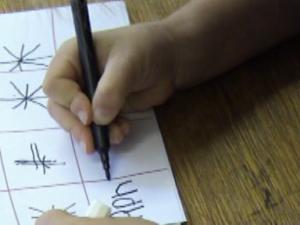
 5
5












































 1
1




raven ranson wrote:My handwriting sucks.
There, I said it. The first step to becoming a better person is identifying the problem.
Dyslexia plus forced righthandedness = really crappy penmanship.
Has anyone here tried improving their penmanship skills as an adult? Is it possible?
I was John Pollard aka poorboy but the system is broken so I had to start anew
 2
2
























 6
6










 1
1




Nicole Alderman wrote:In your case, you might benefit from learning to write in a dyslexia-friendly font. It might retain your hands, while at the same time helping your brain perceive letters better.







 1
1











 3
3




 2
2




 3
3








Nicole Alderman wrote:
I'm wondering if there aren't many books about improving handwriting for adults because, back when people needed good penmanship, they were taught it as children. And, now, when people aren't taught good penmanship, it's not valued, so there aren't many people trying to learn and therefore not much demand for such a book.


























![Filename: practicing-penmanship-s-and-r-confusion.jpg
Description: I used a fine nib Jinhao pen for the sample, but the pen in the picture is the Brush Fountain Pen by Ferris Wheel Press [Thumbnail for practicing-penmanship-s-and-r-confusion.jpg]](/t/97636/a/68936/thumb-practicing-penmanship-s-and-r-confusion.jpg)











 1
1











 5
5




raven ranson wrote:If we don't already know what the words are, or how to spell them, it's difficult to figure out which letters are where.
![Filename: special-aunt.jpg
Description: [Thumbnail for special-aunt.jpg]](/t/97636/a/69184/special-aunt.jpg)













































































 1
1











 3
3




I am only one, but still I am one. I cannot do everything, but still I can do something; and because I cannot do everything, I will not refuse to do something that I can do. (E.E.Hale)
 2
2




 1
1




Tereza Okava wrote:
When dealing with adults with learning disabilities (I was certified in Wilson method), cursive was considered optional-- printing was considered important since survival materials (signage, newspapers, documents) are printed, not cursive. Cursive is the icing, not the cake-- and we NEVER taught it, it simply wasn't the priority. I don't think that means you should just disregard it, though, since it is something you want to do, but i don't think you should be too irked by it.







 2
2




 1
1




 1
1




“Uncertainty is an uncomfortable position. But certainty is an absurd one.”
― Voltaire
 1
1




 4
4




 4
4





|
A new kitten. What are we gonna name it? How about tiny ad?
Learn Permaculture through a little hard work
https://wheaton-labs.com/bootcamp
|








